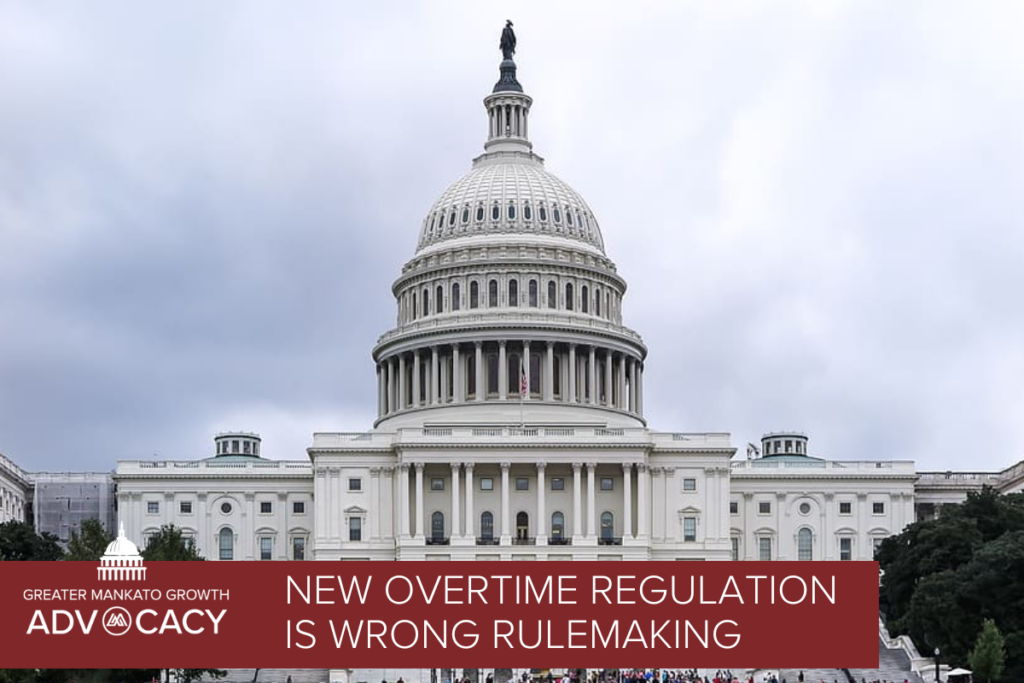This piece was originally posted by the US Chamber of Commerce.
In the Department of Labor’s (DOL’s) latest effort to mimic those Servpro ads about making it “like it never ever happened,” the agency has now issued a new overtime regulation to undo the previous regulation issued by the Trump DOL. The new regulation, published on April 26, will raise the salary threshold for employees classified as executive, administrative, or professional (below which an employee is non-exempt or eligible to earn overtime) in two steps.
The two-step increase came as a surprise. The first increase will take effect on July 1, 2024, and will raise the annual salary from the current level of about $35,600 to about $44,000. On January 1, 2025, that level will go to about $58,600 per year. The final increase will represent about a 63% increase from the current threshold. The rule also includes an automatic escalator clause to reset it every three years, with the first increase hitting July 1, 2027.
Similarly, the increases for employees classified as highly compensated (these employees only have to meet one of the criteria for one of the other exemption categories) will take place in two steps. On July 1, the HCE annual salary threshold will go from about $107,400 to about $132,900. On January 1, 2025, the HCE threshold went to about $151,200, a 41% increase from the current threshold. The HCE threshold will also be adjusted every three years.
Background
For an employee to be exempt from being paid overtime (i.e., not eligible), they must:
- be paid a salary;
- be paid a salary above a specified threshold; and
- meet the defined duties of the specific exemption, such as executive, administrative, or professional (often referred to as EAP or white collar exemptions).
Non-exempt employees must be paid time and a half for any time worked past 40 hours a week.
This means that increasing the salary threshold will force employers to either increase an employee’s salary to maintain their exempt status or reclassify that employee to being on the clock and non-exempt. Note that being eligible to earn overtime does not guarantee that the employee will actually earn any extra compensation through overtime. Instead, employers tend to manage these employees’ hours very closely to keep them at or below 40 hours per week.
Setting the salary threshold has become something of a political football, with the last four presidential administrations putting in place what they thought was the correct threshold. Most notably, the Obama DOL proposed a salary threshold of over $50,000, which was pared back to a little over $47,000 in the final regulation. Even so, this was still more than double the $23,600 that had been in place since the George W. Bush administration.
That Obama regulation (which also included a three-year automatic escalator clause) was struck down by a federal judge in a challenge led by the U.S. Chamber, meaning that the salary threshold reverted to the status quo ante, $23,600. The Trump DOL then finalized a regulation that increased the salary threshold more reasonably to the current level of a little more than $35,000, which went into effect on January 1, 2020.
One common refrain heard during the Obama rulemaking was that workers who would become non-exempt did not want to give up their salaried status and become hourly employees punching a time clock. They enjoyed the flexibility and professional status that were provided by being paid on a salary basis.
That same complaint applies today, perhaps even more so given the prevalence of flexible and hybrid working arrangements in the post-COVID world. Reclassifying some of these employees and putting them on the clock will jeopardize their ability to work remotely, which has been a boon to many workers, and their ability to juggle personal responsibilities such as child care with their professional obligations.
Additional changes in the economy make the boost in the salary threshold even more problematic. Employers continue to struggle to find enough employees and have to pay higher wages as a result. Increasing the cost of labor even further through this regulation will add to their burdens and will be felt particularly severely among small businesses, municipalities, and charitable nonprofits, who can’t just increase prices because they are dependent on contributions to maintain operations.
During the Obama rulemaking Operation Smile, which provides cleft palate surgeries to children in impoverished nations, estimated it would have to reduce the number of operations it performed by more than 4,000 per year because of the increase in the salary threshold.
In what universe is a regulation that limits worker-employee flexibility, raises costs, and forces charities to cut back on their operations a good idea?
Finally, the regulation also includes a “severability clause” that purports to preserve the rest of the regulation if one part (or parts) is struck down by a court. This is a relatively rare concept for a regulation, as agencies cannot dictate to courts how a regulation will be treated if challenged. Severability clauses appear in legislation frequently as Congress does have the authority to preserve legislative provisions.
The DOL is not Congress. The only way to read this is as an admission by the DOL that the automatic escalator clause is vulnerable because the Fair Labor Standards Act does not give the Secretary the authority to put the salary threshold on autopilot. The DOL is simply trying to make sure that if the escalator is struck down, the underlying threshold increase will be retained.
The Bottom Line
The US Chamber believes the automatic escalator clauses are vulnerable, but the DOL is in no position to tell a court how to treat the remaining provisions.
The US Chamber submitted extensive comments criticizing the proposed regulation, but unfortunately, the Department of Labor was not persuaded. The new overtime regulation will likely draw a legal challenge just as the Obama administration regulation did.





